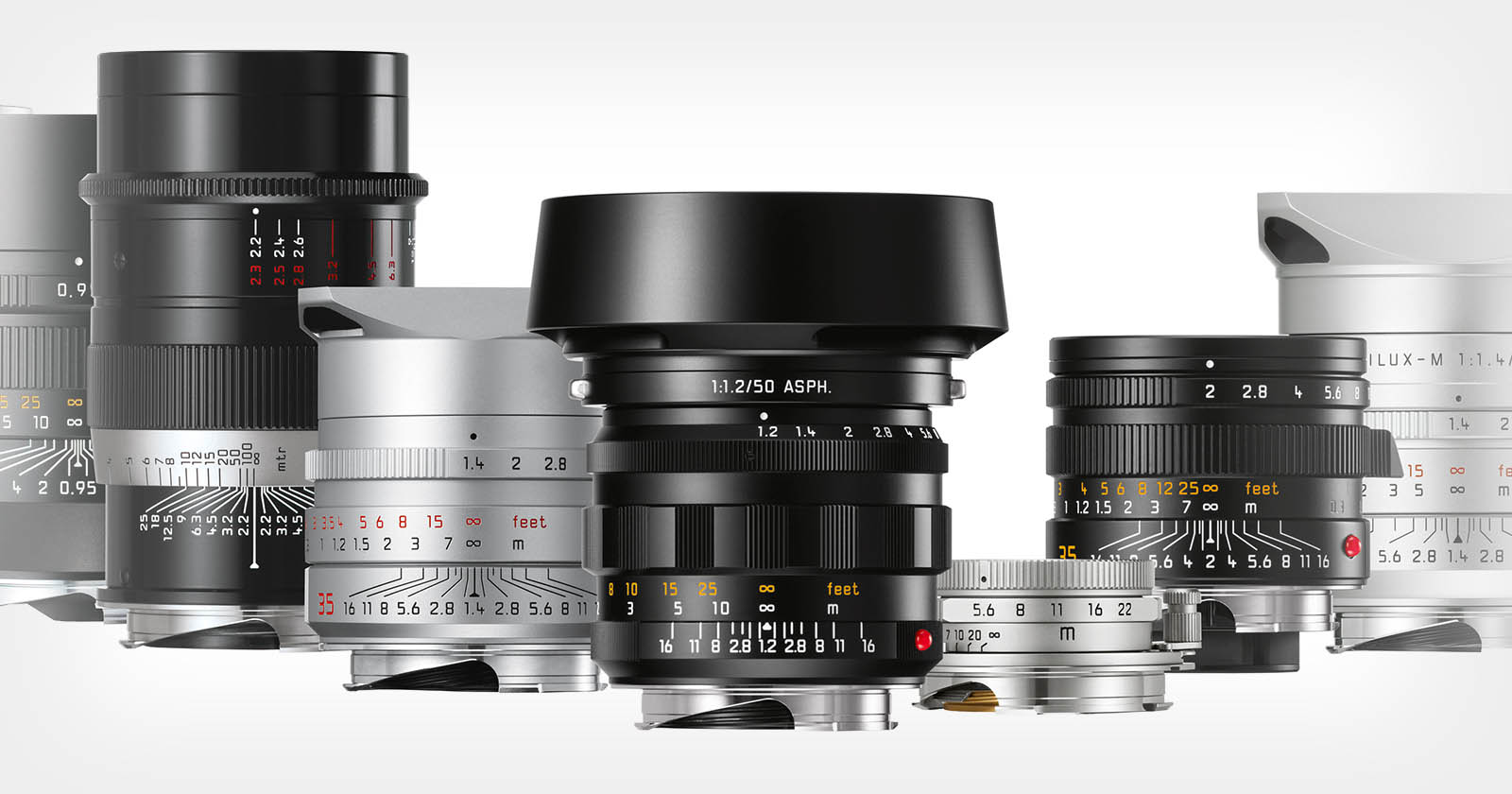
Leica. The name conjures notions of luxury, history, quality, and precision. This especially applies to Leica’s M-mount lenses. While some of Leica’s latest camera bodies like the M11 have gathered praise, the lenses have set the industry gold standard.
This article is a complete guide to Leica M lenses, from picking the right lens for you to understanding Leica’s naming conventions.
Table of Contents
A History in Glass
Leica can be considered a glass company that happens to make cameras. Leitz, the parent company of Leica (LEItz CAmera), originally produced world-renowned microscopes and hunting riflescopes, until employee Oskar Barnack built a compact 35mm camera in 1913 and made history.
Another Leica legend, Max Berek, designed the Elmar 50mm f/3.5 that accompanied the first commercially available Leica camera in 1925. Since then, from wide to standard to tele lenses, nearly all of them primes, Leica M glass has covered world events and created fine art.
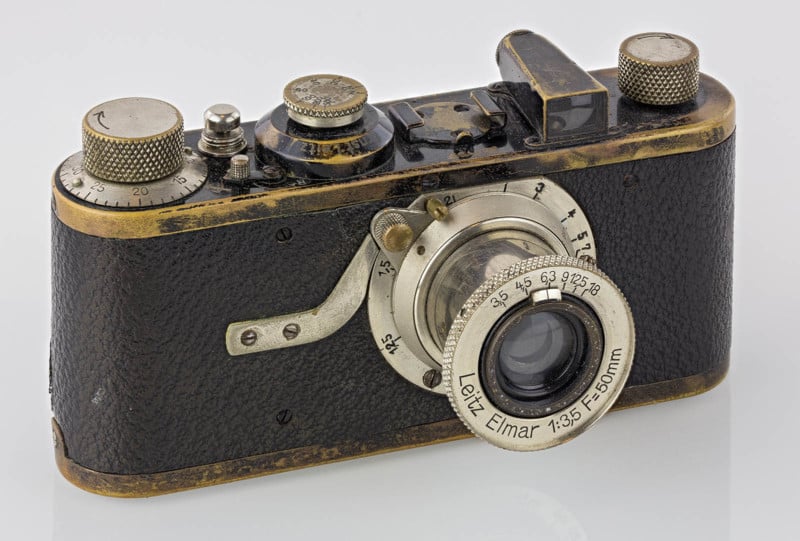
The Leica M-mount, released in 1954, uses a bayonet system. Before that, lenses were screwed onto the camera body. Leica lenses from the 1930s and after can still be used on a digital M camera by way of an adapter. Vintage lenses, especially from 1954 onward, still render exquisite images with unique appeal. At Leica, longevity is tradition.
Lens Name Meanings
The iconic Leica names designate lens speed. For example, an Elmar shoots no faster than f/3.5, an Elmarit is f/2.8, a Summicron is an f/2, a Summilux is an f/1.4 and a Noctilux is f/1.25 or faster.
- Elmar: Maximum aperture f/3.5
- Elmarit: Maximum aperture f/2.8
- Summicron: Maximum aperture f/2
- Summilux: Maximum aperture f/1.4
- Noctilux: Maximum aperture f/1.25 or faster
These names also imply meaning. Take the Noctilux, which derives its name from noct-, meaning night in Latin, and -lux, meaning light. A Noctilux f/0.95 can practically see in the dark. Many lens names include versions that denote design stages and eras, such as the famous Summicron 50mm v2 from 1956, quite a different species from today’s v6 APO-Summicron.

M Lens Categories
Let’s take an even closer look at each of the categories of M-mount lenses, each of which typically contains multiple models with different focal lengths, features, and colors.
Noctilux
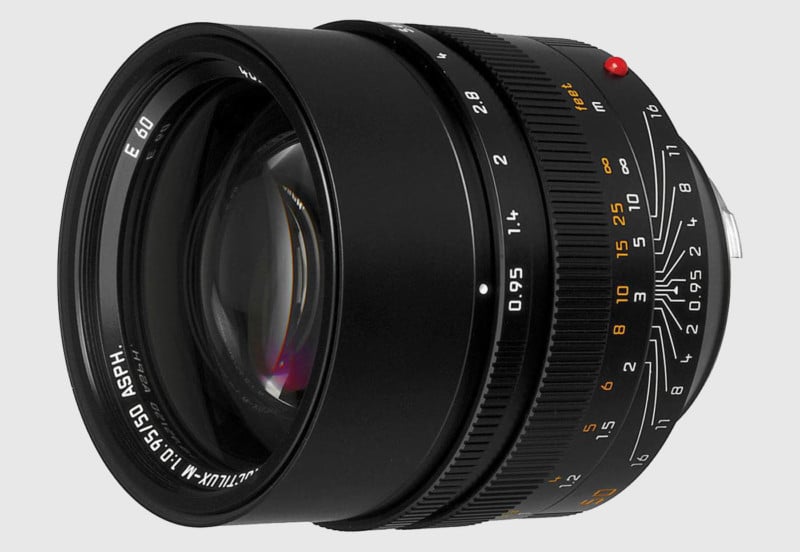
The forbidden lens, and one of the most expensive camera lenses on Earth, the Noctilux broke new ground upon its release in 1966 and continues to dominate today. At f/0.95, Leica calls it “the world’s fastest aspherical lens.”
The Noctilux excels in low light. It also offers the most and the dreamiest bokeh, the quality of the out-of-focus areas in the background of a photo, of any Leica lens. Pleasing, gentle colors also come with a Noctilux. However, such a powerful lens brings challenges. For example, a Noctilux is not easy to shoot wide open in bright light, e.g. outdoors during the day, so ND filters become necessary unless shooting with an M11, or an SL body with an M lens adapter, and their lightning-fast electronic shutter.

Focusing with such a shallow depth of field requires a trained rangefinder eye. At f/1, for example, focusing on a subject six feet away results in a sharp zone less than four inches deep. Up close, a subject’s eye could be in focus while an eyelash is not.
Noctilux images may not be as sharp as those from a Summicron, but the background of a Noctilux photo taken at full aperture becomes so beautiful, who cares?
Summilux
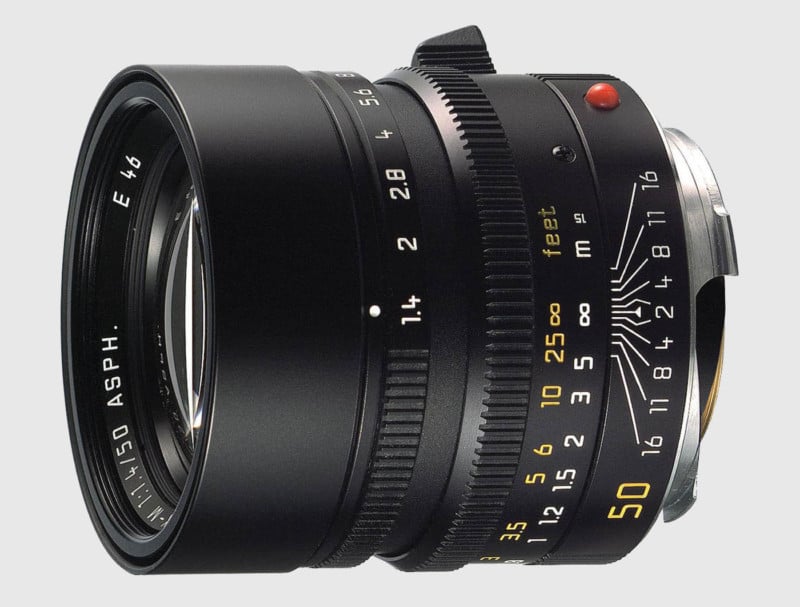
As classic as Leica comes, the Summilux offers a signature glow and a treasured bokeh. The Summilux and Noctilux have much in common. Some call the Noctilux a Summilux on steroids. Both have a fascinating 3D look, meaning high contrast at the point of focus and decreasing contrast into the velvety out-of-focus foreground and background.
The Noctilux bokeh is a bit dreamier, but the Summilux bokeh has a swirly character all of its own. Consider the Summilux 35mm f/1.4, originally released in 1961, widely known as the “king of bokeh.” Besides this, the Summilux creates a smooth light and fairly saturated colors.

While the Summilux lacks the utter sharpness of an APO-Summicron lens, it is faster than any Summicron, and it possesses more of that ineffable “Leica look.” Like the Summicron and Summarit, its prefix refers to a Leica lens from 1933, the Summar, whose etymology remains obscure.

Summicron
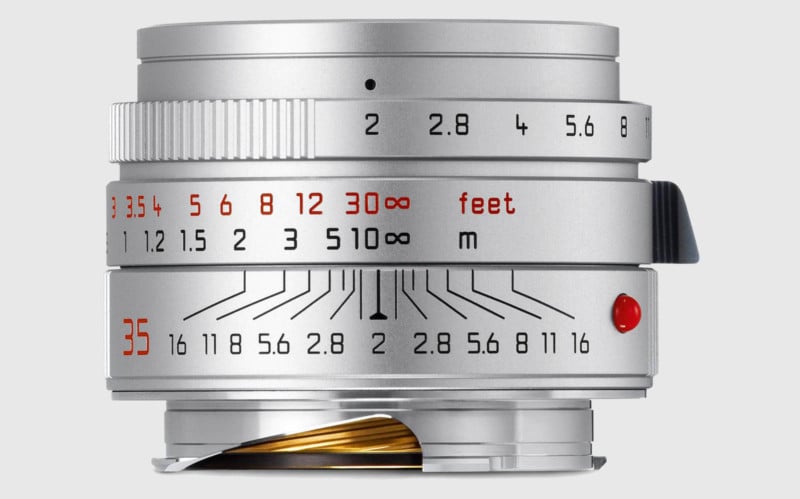
Known for sharpness, the Summicron excels in recording contrast and texture. This makes it very well suited to landscape and studio photography, for example. A standard Summicron (non-APO) costs far less than a Summilux or Noctilux, and while its maximum aperture of f/2 doesn’t deliver the same creamy bokeh as those categories, it still has plenty of benefits.

The Summicron is sharp corner-to-corner even when shot wide open. The current 50mm model, designed in 1979 by the legendary Dr. Walter Mandler, remains non-aspherical yet achieves incredible detail and accurate colors. Summicron bokeh is less opaque, more clinical, and firm than that of the Summilux or Noctilux, and it is smaller, with more defined circles. But at full aperture, a Summicron is much easier to focus.
APO-Summicron
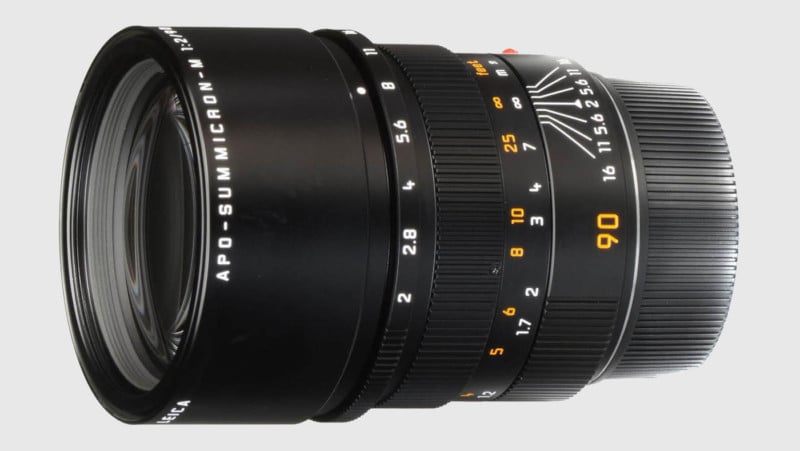
Leica’s APO-Summicron lenses are the meeting point between the Summicron and Summilux. Where the Summicron falls behind the Summilux and Noctilux in bokeh, it more than compensates in crisp detail and fierce color accuracy as an APO (which denotes the apochromatic design).
Chromatic aberration happens when the red, green, and blue wavelengths fail to coincide on the sensor. This results in fringing and flaring. Apochromatic lenses align the RGB waves and in doing so they correct distortion and increase color accuracy, even at full aperture.

APO lenses also send more shades of gray to the sensor, so images become incredibly detailed and rich in contrast. The APO-Summicron yields the highest degree of subject separation due to the intense contrast it creates between the point of focus and the foreground and background. For those who appreciate the clinical look, an APO-Summicron enhances just about everything in a good way.
APO-Telyt
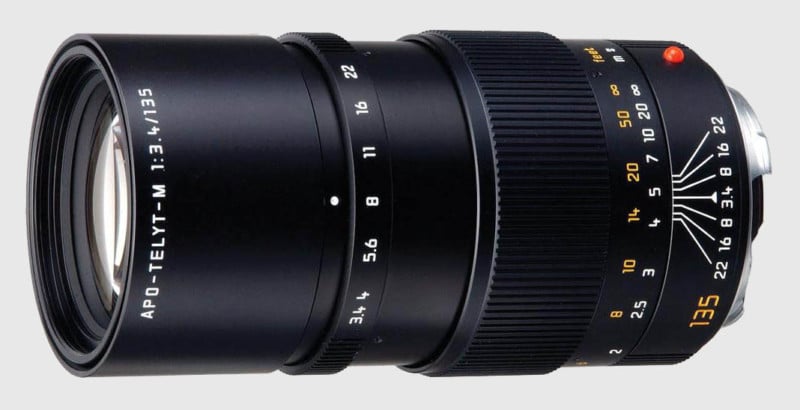
The longest focal length in today’s M lens system, the APO-Telyt 135mm f/3.4 also benefits from apochromatic design. Like the APO-Summicrons, this lens provides striking contrast, sharpness, and resolution at all apertures. But because it’s a telephoto lens with a fastest speed of f/3.4, it earns its own name in the Leica lens family.

Elmarit, Summarit, Summaron

With such a rich history and tradition of crafting the world’s finest lenses, Leica offers its inimitable rendering in even the simplest categories. The Elmarit, Summarit, and Summaron, for example, provide more than enough beauty and character, at a much more approachable price.
Simpler designs and less expensive raw materials help keep the Elmarit, Summarit, and Summaron cost-effective. They are also small, lightweight, and therefore exceptional for street photography. The Tri-Elmar-M 16-18-21 f/4 is the only remaining “zoom” lens in Leica’s current M portfolio. Elmarit, Summarit, and Summaron lenses come in different focal lengths, from macro and wide-angle to tele and all points in between.

Leica M lenses are about more than exclusivity, heavenly bokeh, or absolute sharpness. Each M lens, including the Elmarit, Summarit, and Summaron, offers a picturesque view of the world. Other, older M lenses like the Elmar, Hektor, and Thambar also provide the “Leica look” in their own distinct way. These, however, can be more difficult to find. Fortunately, an active market of pre-owned lenses, including vintage pieces, exists today.
Choosing an M Lens
Few lens companies offer such a wide range of eras from which to choose. Lenses from different decades possess their own take on qualities like bokeh or color. Priorities and tastes change over the decades. Importantly, many lenses come in two categories — pre-aspherical and aspherical — which determines their color accuracy and distortion correction. Mood is an integral part of each Leica lens’ look.
Prime or Zoom?

The vast majority of Leica lenses are prime lenses, so if you prefer using a zoom lens, your options are quite limited. The only one in production at the time of this writing is the $6,500 Leica 16-18-21mm f/4.0 Tri Elmar-M Aspherical lens. Leica also previously produced a Tri-Elmar-M 28–35–50 mm f/4 ASPH.
Aspherical or Not?
So-called “vintage lenses” do not incorporate aspherical elements. Any Leica lens (or, for that matter, any other camera lens) made before the 1966 debut of the Noctilux 50mm f/1.2 is pre-aspherical. With that lens Leica introduced aspherical lens design to the world. Even some of today’s current Leica M-mount offerings, like the Summicron 50mm, designed in 1979, are non-aspherical yet very high-performance.
Pre- or non-aspherical lenses were originally designed for film, which doesn’t carry the same requirements for sharpness, color accuracy, and contrast that a high-resolution sensor does. Instead, these lenses provide more softness to an image. Lines may not appear as straight as they actually are. Colors can render slightly different than what the eye sees.
But this can have a pleasing effect on the final image, whether it be film or digital. Vintage lenses can express a sense of nostalgia, of bygone decades. They can also tame a high-resolution sensor’s clinical precision.
Aspherical lenses, denoted as ASPH, correct distortions and deliver greater color accuracy. They present a more realistic view of a scene or subject than pre- or non-aspherical lenses. Within this category are the apochromatic, or APO, lenses. These remove chromatic aberrations to create an ultra-precise and detailed image with incredible color accuracy, even when shot wide open. In the M-mount, Leica makes APO-Summicron lenses — 35mm, 50mm, 75mm, and 90mm — and the APO-Telyt 135mm f/3.4.
If you are shooting a film Leica M rangefinder, then both older and newer Leica lenses will pair nicely and produce fantastic photos. If you are shooting a newer digital Leica M rangefinder, however, you may want to focus your attention on newer lenses with the latest design technologies, as older lenses may produce things like aberrations, vignetting, and color casts in your photos that you may not find desirable.

Mood
The look that a lens provides helps tell a story. Lenses create mood. Looking to present reality in its every detail, or portray a sci-fi type of sharpness? Choose an APO lens. Telling the story of a young backpacker drifting across the Indian subcontinent? A vintage lens would soften the light and color to express a sense of foreignness and slowed-down time.
Bokeh evokes a sense of mood as well. Leica lenses are famous for their bokeh, and each lens category possesses its own signature bokeh. In fact, much of the “Leica look” includes the beautiful abstractness of bokeh.
For this reason, Leica lens categories differentiate themselves based on how they render when shot wide open. At medium aperture or stopped down, the differences between categories will become less noticeable.
But at full aperture, the bokeh and the separation of the subject from the foreground and background change dramatically from category to category: Noctilux images at f/1 will look very distinct from an Elmarit’s at f/2.8. However, at these full apertures, the focus must be perfect, which is challenging with a rangefinder. A Noctilux requires experience and expertise, not just a fat wallet.
Once a photographer sees how each Leica lens category renders differently, he or she will begin to envision subjects differently. Leica lenses view the world in their own way, which lets photographers include a certain lens’ expression in their own storytelling.
Because the true character of each Leica lens category comes out when shooting wide open, here is where a photographer would ideally make the choice between which lens category to purchase.
Why Are Leica Lenses So Expensive?
Leica is known for having some of the highest price tags for cameras and lenses in the world of photography, and a typical camera and lens pairing can cost as much as a car.
Leica lenses are expensive for several reasons, among which are:
1. Build Quality. One reason is that they are made with high-quality materials and meticulous attention to detail, which adds to the cost of production.
2. Prestige. Leica is one of the most recognizable brands in photography and has a reputation of being almost a luxury good and status symbol in addition to being a piece of useful technology.
3. Limited Quantities. Leica also produces far fewer cameras and lenses compared to other companies with vastly larger market shares. Due to economies of scale, Leica must sell fewer lenses at higher prices compared to mass-market brands that sell far greater numbers of products at far lower prices.
Most Leica naysayers will first attack the price tag. Yes, these are high-end camera systems, especially the M. Pre-owned camera bodies and lenses exist aplenty, but they still often cost more than a new system from another brand.
With the elephant in the room acknowledged, prices for M lenses depend on size and complexity. Smaller, simpler glass elements in the Summicron and Elmarit are easier to produce and require fewer materials, whereas the Summilux and Noctilux use much larger glass elements that require precision across a greater surface area. APO lenses employ highly precise optical designs and require extremely low tolerances for variation, which makes them very expensive. Cool bokeh or blistering detail do not come cheap.
Other Drawbacks of Leica Lenses
Besides price, other drawbacks exist in M lenses. For one thing, M lenses are not weather sealed. They remain open to the elements and will gather dust and moisture. When an M lens is not properly protected or stored, haze and mold can become problematic. Large particulates, including eyelashes, can lodge themselves under the glass.
M lenses require maintenance over the years or decades. They can fall out of adjustment, and parts can come loose. Fortunately, for this and any issues such as mold, dust, or even scratches, M lenses lend themselves to repair. Leica or other accredited technicians can perform a CLA — clean, lubricate, adjust — on even the oldest M-mount lenses. This is good for photographers who put their M lenses to hard work, or for savvy buyers who purchase a somewhat beat-up lens for cheap and pay to have it restored. Leica lenses have no shelf life.
A List of Leica M Lenses
Here is a list of Leica M-mount lenses, both historical ones as well as those currently in production:
- 16-18-21mm f/4 Tri-Elmar-M ASPH
- 28–35–50mm f/4 Tri-Elmar-M ASPH
- 18mm f/3.8 Super-Elmar-M ASPH
- 21mm f/1.4 Summilux-M ASPH
- 21mm f/2.8 Elmarit-M
- 21mm f/2.8 Elmarit-M ASPH
- 21mm f/3.4 Super-Angulon-M
- 21mm f/4.0 Super-Angulon-M
- 24mm f/1.4 Summilux-M ASPH
- 24mm f/2.8 Elmarit-M ASPH
- 24mm f/3.8 Elmar-M ASPH
- 28mm f/5.6 Summaron-M
- 28mm f/1.4 Summilux-M ASPH
- 28mm f/2 Summicron-M ASPH
- 28mm f/2.8 Elmarit-M
- 28mm f/2.8 Elmarit-M ASPH
- 35mm f/1.4 Summilux
- 35mm f/1.4 Summilux-M ASPH
- 35mm f/2 Summicron-M
- 35mm f/2 Summicron-M ASPH
- 35mm f/2.5 Summarit-M
- 50mm f/0.95 Noctilux-M ASPH
- 50mm f/1 Noctilux-M
- 50mm f/1.2 Noctilux-M
- 75mm f/1.25 Noctilux-M
- 50mm f/1.4 Summilux
- 50mm f/1.4 Summilux-M ASPH
- 50mm f/1.5 Summarit
- 50mm f/2 Summicron-M
- 50mm f/2 APO-Summicron-M ASPH
- 50mm f/2.5 Summarit-M
- 50mm f/2.8 Elmar-M
- 75mm f/1.4 Summilux-M
- 75mm f/2 APO-Summicron-M ASPH
- 75mm f/2.5 Summarit-M
- 135mm f/4.0 Elmar
- 90mm f/2.8 Elmarit-M
- 90mm f/2 APO-Summicron-M ASPH
- 90mm f/2.5 Summarit-M
- 90mm f/4 Macro-Elmar-M
- 135mm f/2.8 Elmarit-M
- 135mm f/3.4 APO-Telyt-M
- 135mm f/4.0 Elmar
- 135mm f/4.5 Hektor
Conclusion
A Leica lens may be prohibitive, but the performance, character, and longevity of a Leica M lens might convince some to forgo multiple lenses in place of a single piece of Leica glass. Few, if any, other brand lenses convey mood and identity like a Leica.
Shooting a Leica M lens means slowing down, concentrating on the essence and roots of photography, and maintaining a commitment to artistic beauty. For many, owning a Leica M lens proves a crowning achievement, a lifelong possession, and a good reason to play the lottery. With Noctilux and Summilux bokeh, and APO-Summicron precision, Leica encourages photographers to dream.
Image credits: Header photo courtesy Leica Camera







